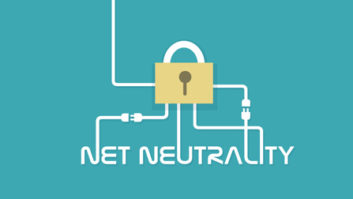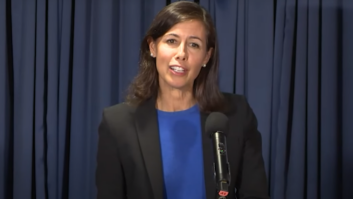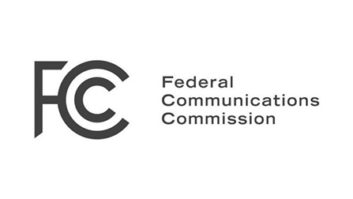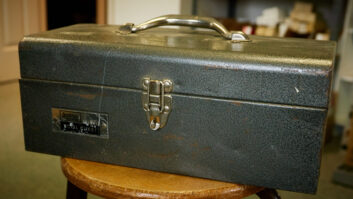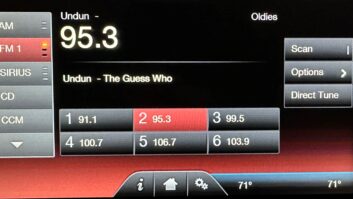Every NAB Show reinforces the realization that our industry will always be blessed, and at the same time held hostage, by the marvels of electronic technology. Content may be king, but it will forever be transmitted and received by wireless or wired communications devices.
Although over-the-air radio has enjoyed 90 years as the primary delivery method, it’s becoming clear we are at the forefront of a paradigm shift. Streaming and the Internet are beginning to share the load.
To remain competitive, no form of electronic media can afford to ignore the imperative and force of advancing technology. But as broadcasting grapples with how best to harness the Internet, streaming and other new digital opportunities, typically nine-tenths percent or more of its ongoing revenue and business model is based on supporting its traditional over-the-air product. Digital asset income may be increasing, but it’s still a tiny part of the net income pie chart for radio.
Just how much effort and financial resource should be devoted to new initiatives is a vexing question for management in any size station or market. Early adopters traditionally lead the industry and often get rewarded, but they always take on the most risk and sometimes get burned. Radio stations everywhere continue to wrestle with deciding if and/or when to convert to HD. Practically every station has a Web site, but most small-market stations still do not stream over the Web.
CONTRARIAN THINKING
For many cost-conscious radio owners and managers, their Internet product is more of a distraction and cost burden than a significant contributor to the bottom line.
Except for Google and online marketers like Amazon, few businesses have figured out a model that makes real money from their Internet presence.
Just before the dot.com bust, then-CBS boss (and now Sirius CEO) Mel Karmazin proclaimed that the Internet was merely a very big electronic Yellow Pages. He thought Web sites were little more than a value-added accessory for radio, and did not even allow CBS stations to stream.
But nowadays if you don’t have a decent Web site and online stream, many advertisers conclude you are not where they think their customers are spending lots of their time. Unless you have a compelling ratings story to tell, not being available on the Internet may leave you off the buy.
Most managers who live and die by quarterly performance figure it’s simply much too early to worry about wireless Internet competing head-to-head with radio. It’s true that we have a lot of issues to sort out, as the various players in the wireless mobile space jockey for position. WiMax is being pushed hard by the revived Sprint/Nextel and Clearwire partnership, using both 3G and 4G technology; $14.5 billion is being ponied up to develop their nationwide WiMax network, including support by heavyweights Intel, Google, Comcast and Time-Warner.
A brand-new technology certain to compete with WiMax called LTE (Long Term Evolution) is now being developed in Europe. AT&T Wireless and Verizon, the largest U.S. wireless operators and the winners of the big FCC spectrum auction, have just indicated they are choosing LTE for their mobile Internet service of the future.
The collision of different and competing technologies will slow down the rollout of new consumer electronics platforms. New-generation wireless will need some kind of standardization in order to become widely adopted and successful.
SITTING ON THE SIDELINES
Quite a few radio decision-makers have decided that until HD-R receiver sales and penetration start to show up on their radar screens, adding HD Radio is not yet justified as an investment to grow their business. They’re content to leave HD-R evolution to Ibiquity stakeholders, and will continue to rely on the same basic AM-FM formula that has served them well for many, many years. Lots of stations continue to churn out tons of cash with the old tried and true, making up to 50 percent of the bottom line.
The recession aside, radio profit margins may have fallen a little but still are lofty compared with most other businesses. Overall ratings also may be down a little, but everyone who is paying attention realizes 225 million listeners still use and depend on our product every day, in every nook and cranny across America. This “treading water” mode of thinking seems to have considerable support, especially outside the larger markets.
Unfortunately, Wall Street has punished broadcasting because it is not growing. Broadcasting also is being squeezed by the glitzier new technology mass media entrants for attention. Many of those new technologies have yet to attract significant or sustainable audiences or make a profit. Ad agencies and buyers are caught up in that same ripple and, like Wall Street, seem overly enamored with the Internet and new tech while they ignore or forget radio’s strengths.
TO CHANGE OR NOT TO CHANGE
Continuing to run radio by the methods and strategies that have always worked in the past certainly provides the path of least resistance with apparent minimal risk. Nobody likes change if it creates uncertainty with unpredictable or money-wasting results. But resisting change in a business that thrives on and showcases the new and novel will always become even more risky sooner than later.
Both the programming and technology histories of radio are highlighted with new introductions that began as experiments and eventually became staples of enduring success. That pattern is one thing that will probably never change.
Innovation is the mother of change and has a hard time slowing down or waiting for better economic times, especially with personal electronics. Enhancements in streaming, wireless/mobile and digital technologies again dominated this year’s NAB Show and continue to push broadcasting.
Some of these are poised to create more competition to traditional broadcasting while at the same time offering us opportunities to make our own products better or to partner with competitors. The cumulative changes the industry has had to embrace over the past five years rival those of the previous 20 years. And there are more coming every day.
Many managers, PDs, AEs, production folks and engineers are spending a lot of time and effort managing their burgeoning digital assets, including HD channels. Most of those are producing little or no revenue or audience compared to their primary over-the-air programming. That’s going to be the price we’ll have to pay to give these new platforms a chance to build audience and create results.
THE 10 dB BUZZ
There is little doubt that FM-HD continues to make important gains, growing and expanding its supplemental channel format offerings in many markets. The vitally important HD consideration buzzing everywhere at NAB was the proposed 10 dB digital power increase. The higher digital power is required to improve indoor reception and make supplemental channels more viable.
Several Ibiquity partners conducted field tests of the proposal earlier this year including Greater Media and CBS. Co-channel stations, especially those short-spaced, are the most likely to receive increased interference. Many first adjacents also will feel the pinch. But the overall conclusions of this first round of tests were promising.
There is no question that primary coverage areas for digital reception will expand substantially with such an increase and all HD channels will perform much more reliably. That’s a very positive shot in the arm, not only for HD Radio but for radio in general. This is a case of the greater good outweighing the more limited downside of isolated increased interference.
Just how much of the 10 dB increase will eventually be allowed and how it’s implemented will be the industry hot topic in the months to come.
It seems reasonable that the Federal Communications Commission will allow up to 10 dB but will place limitations for stations in congested areas based on projected contour overlap using computerized modeling methods. Or, as it has done with AM-HD, there’s always a chance it will let interference issues be handled first by the stations themselves bilaterally after the ground rules are established. Then if that doesn’t work, the commission will step in on a case-by-case basis.
BACK TO THE PRESENT
Ibiquity showcased 60 new HD receiver models in its NAB booth this year, including several with Apple’s iTunes tagging. That feature, along with display data, extra channels and on-demand programming, are among the key ingredients that should make HD Radio a desirable upgrade as time moves on. Enhanced audio quality is a bonus.
AM-HD continues to fight a precarious battle for acceptance. Nautel showed its impressive new NX-50 transmitter at the NAB Show, designed specifically to optimize and maintain high-quality HD performance. It even won a “Cool Stuff” Award. All the major equipment manufacturers offer excellent options for AM-HD hardware solutions. Yet the growth of AM-HD stations coming on the air seems stalemated.
We are hearing that several major groups including Bonneville are now pulling back on AM-HD and re-negotiating their commitments with Ibiquity. As RW noted in a recent editorial, if true that development is not good news for AM as the service struggles to remain relevant in a digital world. AM-HD may be flawed in various ways, but it remains the only game in town selling tickets for tomorrow’s show.
The primary players of the HD rollout appear steadfastly committed to a long and steady effort in spite of the slow uphill climb. But without critical-mass acceptance, deployment and promotion of HD by more stations across markets of all sizes, the receiver folks are not yet willing to stamp this technology a winner. The car radio still holds the key that will start this engine and keep it running.
We’ve heard a lot of talk and promises from Ibiquity and the HD Alliance. A few car companies have stepped up to play, but until all the Big Three U.S. car companies supply HD Radios as standard OEM equipment without option surcharges, HD demand, receiver sales and market penetration are not likely to accelerate.
Consumers have been comfortable buying radios for less than $20 for many years. Convincing them to buy a new and improved model for $100 or more is not an easy sell. It’s just the nature of the beast.
GETTING TO THE FUTURE
In a way, we are caught in an HD Radio Catch-22.
While we cannot predict the future, many hope it could come sooner than later. The stakeholders and big boys are trying to do their part but the benchwarmers sitting on the sidelines are not helping.
Many of them would just love to wake up tomorrow and see HD Radios in every store and every car so their decision to buy the hardware and the licensing would be a no-brainer. If only the 10 dB digital power increase would be authorized very soon. If only cheaper and better performing HD receivers, including stock car radios were available now.
The future that HD proponents dream about could be just around the corner. Or it could get stalled and eventually derailed. It’s still mostly up to us. Radio needs to do a lot more heavy lifting with much better execution and promotion of the service to convince consumers HD Radio is worth having. Unless we do our part and make sure HD programming is compelling and reliable, the future for radio that includes a successful HD service may not come.
Staying with the analog status-quo indefinitely, especially on FM, simply makes no sense for stations and their listeners, or for receiver manufacturers, car companies and retail vendors who want to sell anything new and improved. HD remains our only shot right now in giving radio a desirable new feature set to better serve consumers in an all-digital multimedia world.
One last possible caveat to ponder: A lot of radio folks are thinking that even if HD catches on, it probably won’t get anything close to the long and storied run AM and FM have enjoyed. The times have changed. Significant technology advances that used to take 20 years to mature and become entrenched now appear and then disappear in less time than that.
Wireless Internet has the potential to absorb and ultimately replace traditional radio broadcasting as we know it. Las Vegas should consider offering odds on if and when that will actually happen. The platform that might eventually become the dominant nationwide wireless standard is unknown and will take many more years to evolve.
Hoping for the future to arrive quickly may not be what we really want after all. The clock is ticking.






